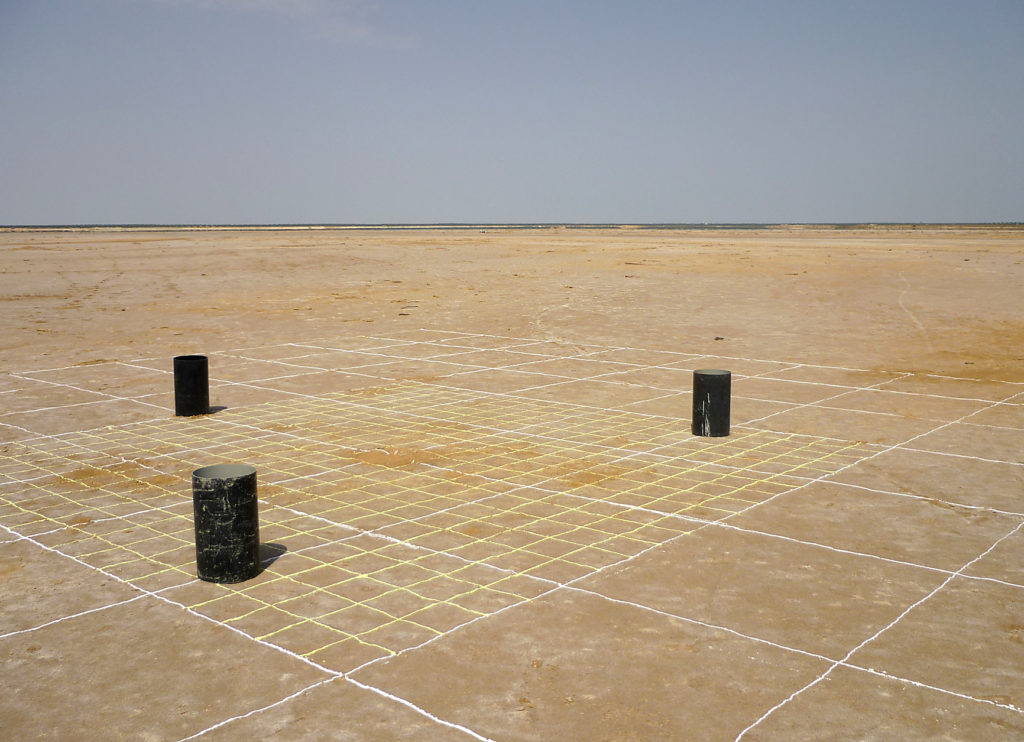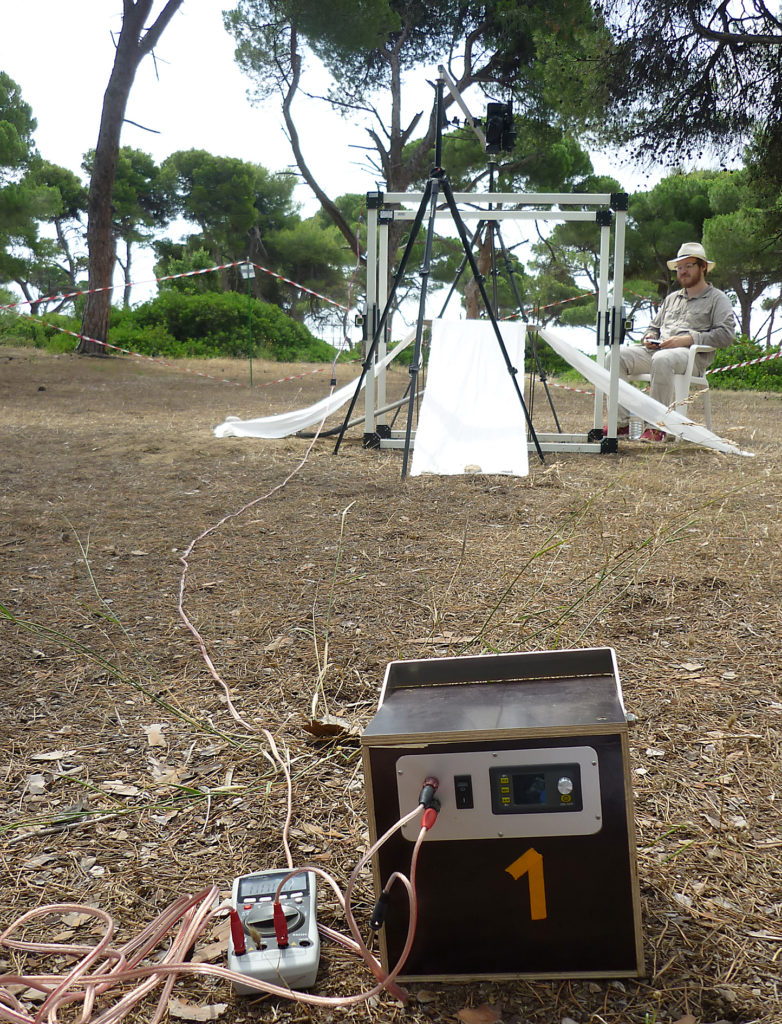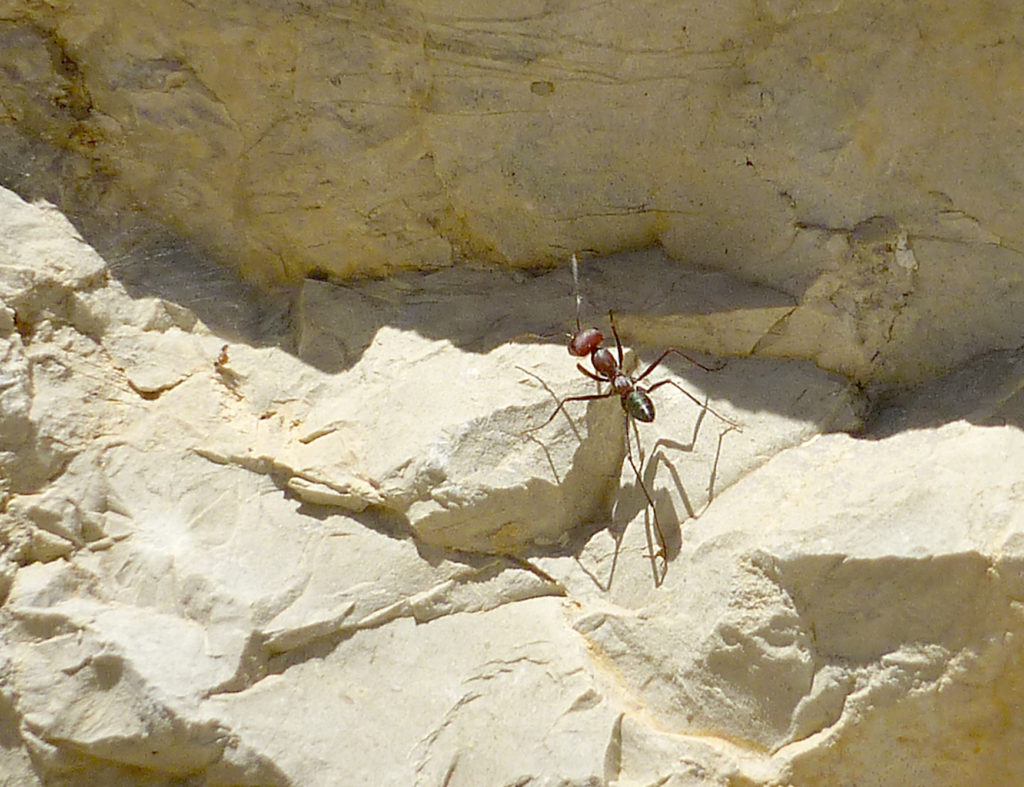The learning walks of ants
When transitioning from in-nest duties to their foraging life outside the nest, ants perform a series of highly choreographed learning walks around the nest entrance, before leaving to forage for the first time. In the recently published review article “The learning walks of ants“ Jochen Zeil and Pauline N. Fleischmann review these learning walks and emphasize on understanding the functional significance of this learning process for efficient homing in ants. Here, both authors share some pictures of their fieldwork and answer questions about their research.
A Photoblog compiled by Pauline N. Fleischmann and Jochen Zeil

All pictures are © Pauline N. Fleischmann
An Interview compiled by Patrick Krapf

MNB: Could you tell us a bit about yourself?
PNF: I am a postdoc in Würzburg working on desert ant navigation. Since this year, I have my own DFG-funded project entitled “The Dynamics of Geomagnetic and Celestial Compass Cues in Cataglyphis Ant Navigation”. In spring 2018, I completed my PhD in Wolfgang Rössler’s lab (Neuroethology), chair of Zoology II at the JMU Würzburg. During my doctoral project under the supervision of Wolfgang and Rüdiger Wehner (University of Zurich), I spent the summer months with Cataglyphis ants in Tunisia and in Greece, respectively. Prior to this, I studied Philosophy as well as Neurobiology and Behavior in Berlin (Germany) and Trondheim (Norway). Now – after one year of parental leave – I am back at the university. I just returned from Greece where I performed this year’s field season.
MNB: Oh wow, and could you briefly outline your research on the learning walks of ants you published in Myrmecol. News in layman’s terms?
PNF: In short, I investigate how desert ants learn to navigate. Some ant species, for example “my” Cataglyphis ants, are so-called solitary central place foragers. They leave the nest alone and search for food in the nest’s surroundings. When finding a prey item, they return to the nest – a tiny hole in the ground that is invisible from the ant’s perspective – in a straight line. The underlying navigational mechanism is called path integration. It enables the ants to forage long distances and to home successfully over the shortest possible path. They integrate compass and distance information to calculate their home vector at each and every point of their journey. In addition, they use any cue available for navigation, for example, visual and olfactory landmarks, the ground structure, or wind direction. The ants’ navigational performances become even more impressive when considering that they live underground for most time of their lives. To calibrate their compass systems and to acquire all information necessary for their foraging tasks, they perform learning walks. Learning walks are short trips around the nest entrance during which the naïve ants, so-called novices, do not collect any food, but explore the nest’s surroundings. Our review compares learning walks across species and reveals a pattern of similarities and differences. For example, the structure of the habitat seems to have a significant impact on the structure of the learning walks. In that sense, evolution worked as an experiment for us. By comparing both closely and more distantly related species inhabiting different environments we can thus relate certain behavioral patterns to their functional tasks.

Building the test field is a time-consuming task. Precision is worthwhile and each year at least one student is deeply impressed by the fact that the theorem of Pythagoras works also in the field and large-scale. 
Moat setup for a displacement experiment. One field assistant marks ants at the nest entrance, the other one notes all feeder visits of individually marked foragers. 
Experimental setup with test grid to enable recordings of learning walks and foraging trips true to scale with pen and paper. 
View from the feeder along the moat to the release point where the test ant’s home run will start and its search for the nest entrance will be recorded. 
1. Helmholtz-coil setup in the Greek pine forest. One experimenter observes the happenings on the experimental table and starts the high-speed recordings. The other experimenter controls the power supply and takes notes in the field book. 
Naïve and experienced ant researchers around the experimental setup consisting of a high-speed camera and a filter system to manipulate the celestial cues above the nest entrance. 
Experimental setup to record the learning walks of Cataglyphis fortis novices. The observer sits in 5m distance, watches the nest entrance with binoculars and starts the high-speed recordings via remote control when an ant leaves the nest entrance.
MNB: What is the take-home message of your work?
PNF: Learning walks are crucial. Only if novices have enough time and space to perform their learning walks undisturbed at the beginning of their foraging career, they can become successful foragers later on. That means that learning walks are essential for a single ant and, therefore, for the survival of the whole colony. The behavioral transition from interior worker to exterior forager is rather sudden. After spending most times of their lives underground in the dark nest, Cataglyphis ants perform learning walks for up to three days. But not only the behavior changes drastically within this time span, also within the tiny ant brain a lot of changes happen at the same time. For that reason, Cataglyphis ants are ideal experimental models to study both their impressive navigational skills and the underlying neuronal plasticity. Since we found out that novices use the earth’s magnetic field for path integration during learning walks, Cataglyphis ants are in addition a highly promising model for future studies on magnetoreception.
MNB: What was your motivation for this study?
PNF: Jochen and I have had a cooperation since 2014. In our discussions about the learning walks of ants, we detected both similarities and differences between our study species. In the present review, we summarize our accumulated knowledge. The goal has been to present the state of knowledge and to highlight the most important research questions that need to be tackled in the future.
MNB: What was the biggest obstacle you had to overcome in this project?
PNF: The experiments that I performed and that are reviewed in the article were performed during my PhD project. The major challenge was to establish the new field site in Greece after I had to cancel the field season planned for Tunisia due to the political situation in Northern Africa in the summer of 2015. Working with another species in a completely different environment forced me to develop new research questions and to design new experimental approaches. In the end, this switch from Tunisia to Greece turned out to be very beneficial. Who knows whether we would have found that ants use the Earth’s magnetic field as a reference system during their learning walks if we continued to work in Tunisia – in fact it is still an open question whether other ants than the Greek Cataglyphis nodus use the magnetic field during learning walks.

A Cataglyphis nodus ant at the artificial nest entrance on the experimental table. 
A Cataglyphis nodus forager climbs on a rock. 
A Cataglyphis fortis forager drinks on a piece of a watermelon that we placed on the saltpan. 
Individually marked foragers (Cataglyphis fortis) visit one of our feeders (a grape) and drink greedily.
MNB: Oh wow, what a coincidence. And do you have any tips for others who are interested in doing related research?
PNF: For the research on ant learning walks, the same rules apply as for any other research. Maybe the following hints are especially important for behavioral experiments in the field, because Murphy’s Law (“Anything that can go wrong, will go wrong.”) applies especially in situations when you’re on your own – for example in the desert. In case something does not work out as planned, it is very helpful to be creative in order to find another solution. And as during all behavioral experiments, the experimenter has to be very persistent and patient. The best thing is when you are excited by what you are studying. Fascination and joy are the greatest incitement I know of.
MNB: Nicely put. And where do you see the future for this particular field of ant research?
PNF: There are many open questions concerning ant learning walks – and my impression is that the more we find out about this topic, the more questions we open up. For me personally, the most pressing question at the moment is how and why Cataglyphis ants switch from the newly discovered magnet compass they use during learning walks to the celestial compass during foraging. Answering this question will be crucial for two as yet mostly separate research areas: neuroethology of insect navigation and sensory biology of magnetoreception, and this may be the beginning of a completely new line of research.

The trees and bushes in the Greek pine forest offer a prominent landmark panorama that is used by Cataglyphis nodus ants for navigation during foraging. 
Foragers (Cataglyphis fortis) feed on a cranberry where they are caught and marked individually with a three-dot color code using car paint. 
A Cataglyphis nodus ant leaves its nest. 
Salty crust of the saltpan. 
View on the saltpan in Tunisia – almost no natural panorama is available for orientation. 
Bird’s eye view on the Schinias Nationalpark near Marathon, Greece. Our experiments are conducted in the pine forest at the coast.






















Recent Comments